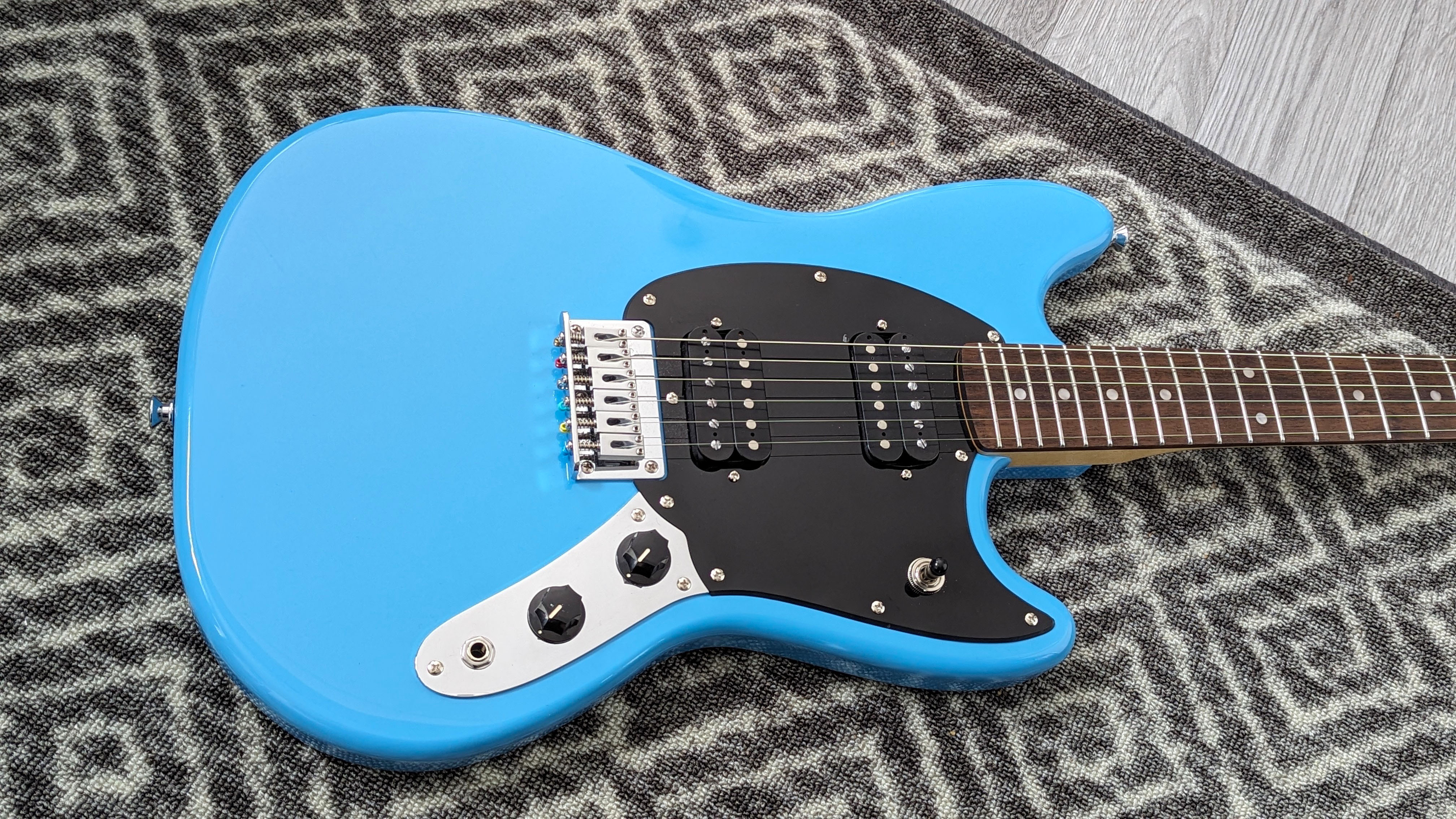MusicRadar Verdict
MusicRadar verdict: An excellent value electric guitar that offers a really positive playing experience for developing guitarists – and especially younger ones. The Mustang shape, versatile pickups and a very comfortable neck help to make this one of the best guitars for beginners available.
Pros
- +
Fantastic playability
- +
Scale length is ideal for smaller guitarists
- +
Versatile pickups at this price
- +
Great value
Cons
- -
Limited finish options currently available
- -
The previous Bullet model's contoured belly cut is missing
- -
The 24" scale may be too short for some
MusicRadar's got your back
Squier Sonic Mustang HH review: What it is?
The best beginner guitars don't just need to be affordable, they have to be much more than that. There are a lot more expectations on their shoulders than mere price; they have to ease a new player in, be comfortable and inspire… because this could be the start of a beautiful friendship and a musical journey that lasts a lifetime. No pressure then.
Squier is a brand that can offer many things – not just a way in for newcomers. The Classic Vibe series is an excellent affordable alternative to Fender's American and Mexican-made vintage-leaning lines, and the Squier Paranormal series can offer up hybrid and unexpected models we may never see with a Fender logo on the headstock. It's the Squier Bullet line that has provided the first step into the world of Fender designs since the first days of the Fender brand in the early 80s, but in 2023 that became the Sonic Series.
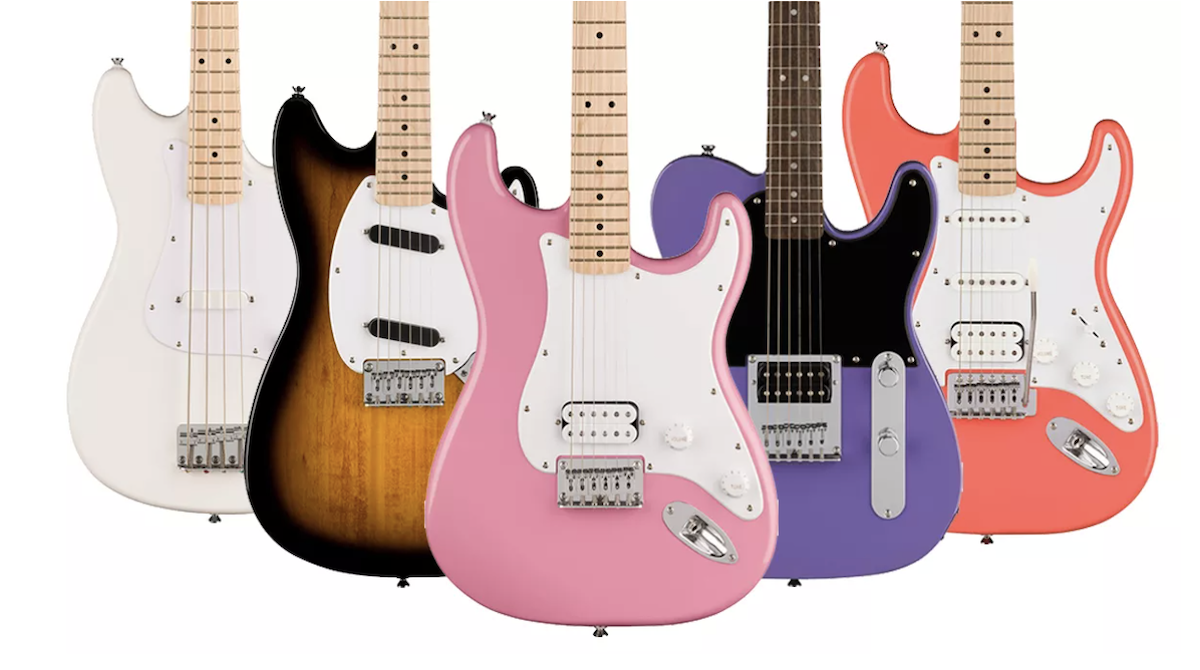
These remain the most affordable Squiers and they're still aimed at new players in first and foremost. With this in mind they need to make a good impression to keep those players coming back to Fender guitars later on as they develop. So Fender's iconic Telecaster and Stratocaster guitars are represented alongside Precision Bass models as we would expect. But there are some surprises too in the Spnic series; a humbucker-loaded Esquire, Bronco Bass and single-humbucker hardtail Strat, widening the potential appeal further with enhanced choice.
This kind of HH Mustang was part of the Bullet range with different finish options, and we reviewed one backing 2021. It impressed us so in so much as a beginner guitar and a great buy in our review that we added it to our best guitars for beginners guide. But with a new model comes the need to reassess and find out if the Sonic version can draw similar praise.
As I said at the start, the pressure is on here.
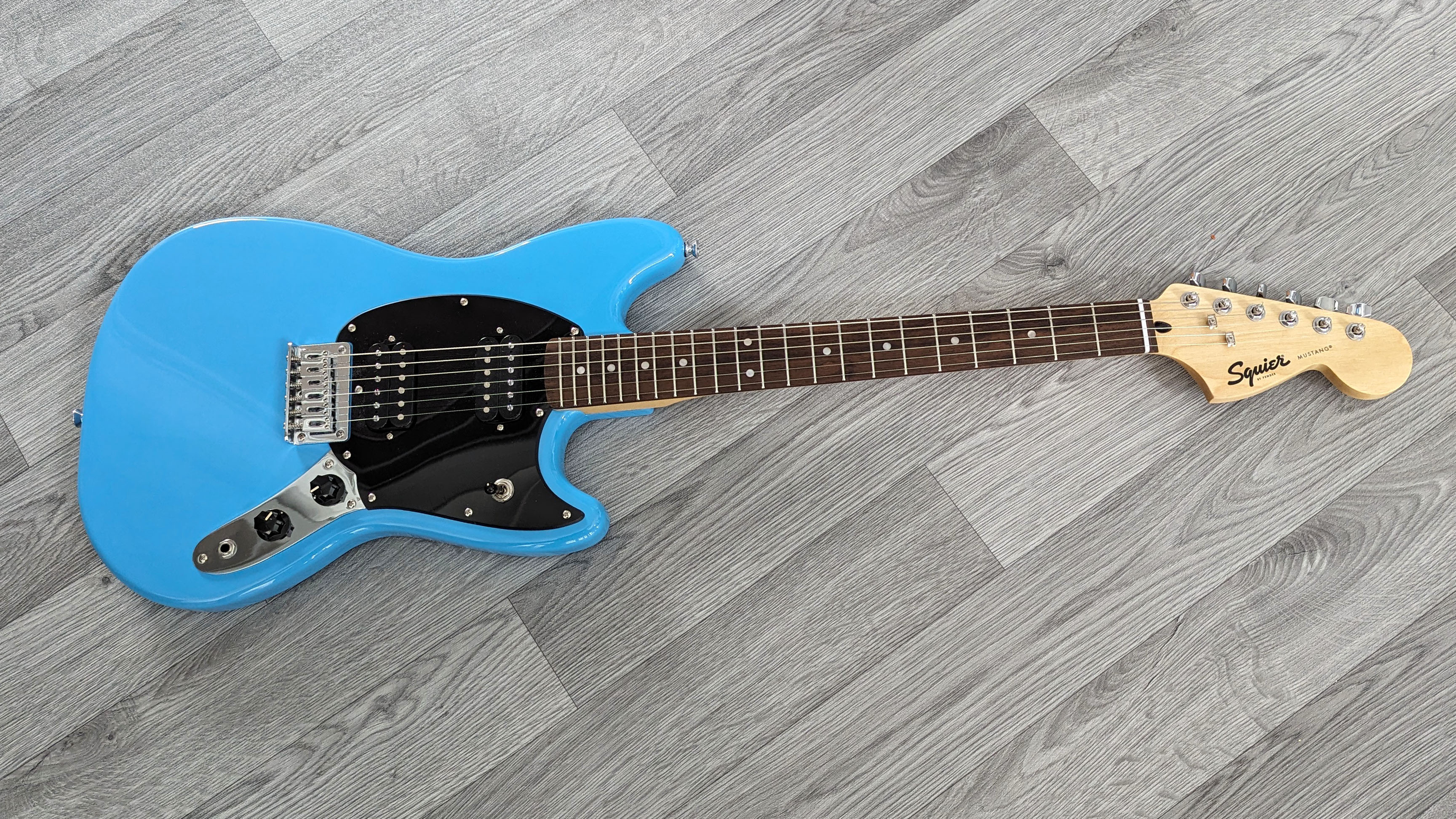
Squier Sonic Mustang HH review: Performance
It feels like things have come a long way since I grappled with a red Marlin Slammer that had action like a cheese grater. Back then I didn't even know about truss rods, let alone adjusting one. While the whole 'back in my day' may apply to a fair few things, there's no doubt the entry-level side of the market is vastly improved now in terms of what you can get for the money. But it's also much more crowded and there's a huge array of options. Squier is not one of the only games in town anymore.
Maybe those memories of early struggle linger longer than you might imagine, but I've now become very keen on the idea of making things as easy as possible with guitars. Low action, as light a gauge string set as I can get away with. I always think of the story of BB King picking up Billy Gibbons's guitar, strumming it and asking him, 'Why you working so hard?' BB was a wise, wise man indeed. And that's also why I now play mostly play a Mustang.
Want all the hottest music and gear news, reviews, deals, features and more, direct to your inbox? Sign up here.
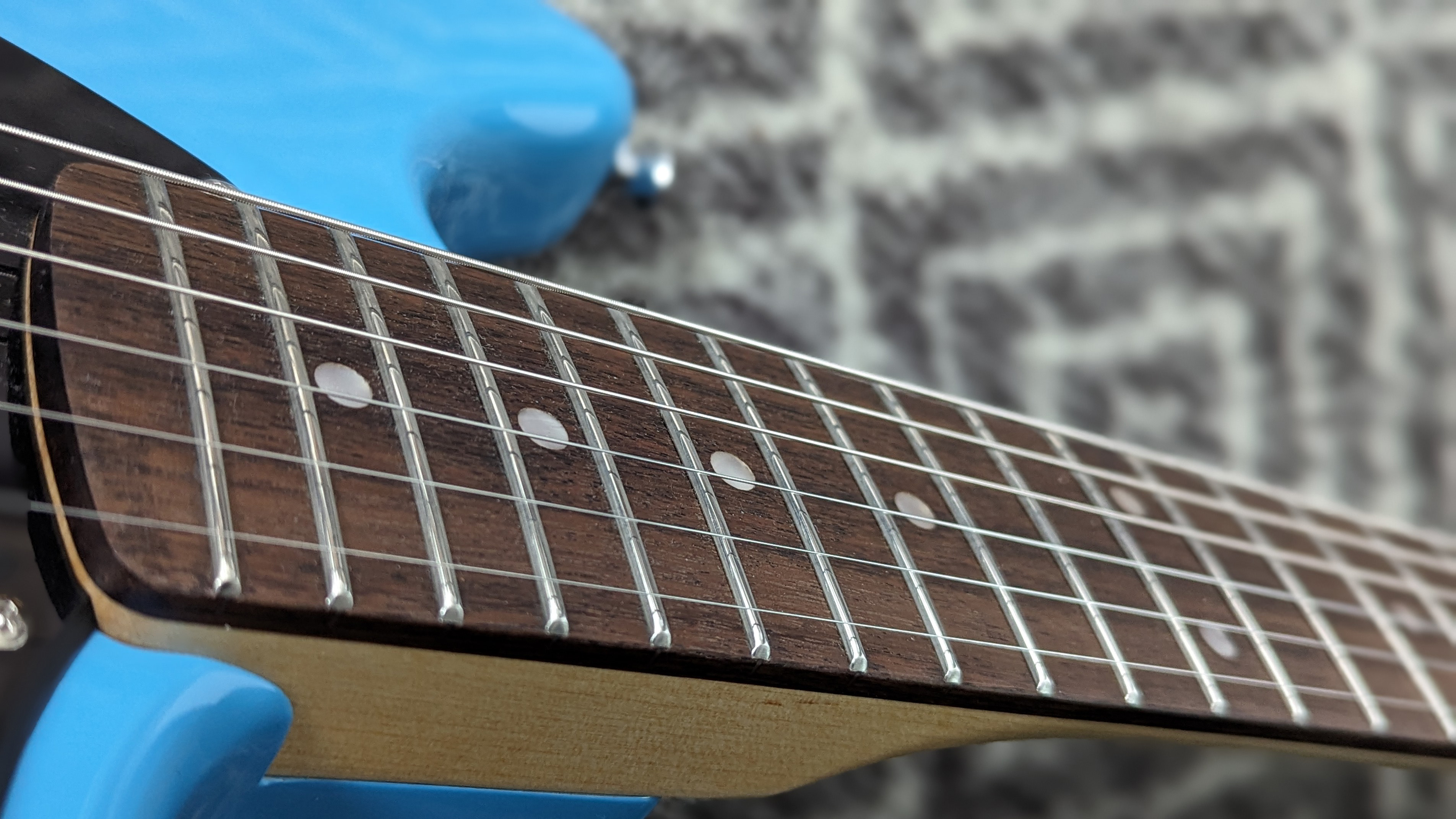
The short scale isn't for everyone; if you're of a taller stature it can seem a little toy-like, but I love it. While a Strat and Tele are 25.5", the Mustang, like the Fender Jaguar and Duo-Sonic, are 24". The scale length is the distance from the front edge of the guitar's nut to the very centre of the 12th fret, then doubled. A shorter scale length means frets are closer together and there's less string tension because less length of fingerboard to stretch them over. The first makes chords easier, especially when stretching, and the second makes bending strings easier in general. The feel is slinkier. And that can be great for newer, and especially younger, players getting to grips with an electric guitar neck for the first time.
None of that would make any difference if the neck itself was a duffer but it's a great showcase for the Fender family and a key factor in this guitar's appeal
Some players like to account for a short scale length with higher gauge electric guitar strings – the idea being that a gauge 10 set will feel like a gauge 9 on a Mustang. This guitar ships with 9s, which is pushing it a bit. The furthest I've gone with a short-scale guitar is 9.5s and I'd consider that unusual. And yet, the 9s makes really good sense for a new guitar player, allowing those first steps of fingertip callus-building much less arduous.
The action here is low and friendly but not actually that buzzy after I make a slight truss rod adjustment. I think starting with the stock set and building up to the optimum gauge of a set of 10s would be the best way to go for a beginner and encourage more confidence when it comes to developing the vibrato that helps to inform your personality as a guitarist. Adult players with some experience will probably want to swap the stock set to 10s or even 11s.
None of that would make any difference if the neck itself was a duffer but it's a great showcase for the Fender family and a key factor in this guitar's appeal. The satin finish on the back here is always preferred to gloss when it comes to smooth comfort and easy movement up and down the neck, while the C-shape with a 9.5 radius is a safe bet for the widest appeal. It just feels instantly comfortable and welcoming, with the narrow tall frets adding to the slinky fast feel of the fretboard. I think these features combine to make a really positive playing experience for a new guitar player.

A few things have changed in the build here compared to the Bullet series HH Mustang. The body wood is now poplar where previously it was basswood, but more importantly the rear body belly contour has been dropped in favour of a slab body. This is a shame, as this kind of contour can only be a positive attribute when it comes to comfort standing with the guitar. Though with a body this thin – as we'll find out – it's less of an issue compared to something like a Strat.
I actually prefer the look of the Indian laurel here to the pau ferro on many Fender Mexico models that are considerably more expensive than this
The biggest change reflects a shift at Fender post-CITES restrictions on the sale of rosewood; the Bullet HH Mustang originally had a rosewood fretboard. That's now become more of a premium feature on US and Japan Fenders, plus some of the more premium-priced Mexican Fender guitars. So it's a shame the way things have gone because you were getting more for your money on the neck side before with Squiers, but it's the reality now with the Fender family – and indeed some other big guitar brands.
However, I actually prefer the look of the Indian laurel here to the pau ferro on many Fender Mexico models that are considerably more expensive than this; it's less streaky and darker like that, now more premium option, rosewood.
The California Blue finish of the body is certainly a bright contrast with it. Though I personally preferred the Imperial Blue of the old Bullet version, the other option is Flash Pink with maple fingerboard which feels a bit limiting to be honest. I did find a limited Sonic Blue option with maple neck on backorder at Thomann and this lovely Limited Edition Black finish / maple fretboard option that's also out of stock on the Fender site, but It would have been nice to see some available options beyond just blue and pink!
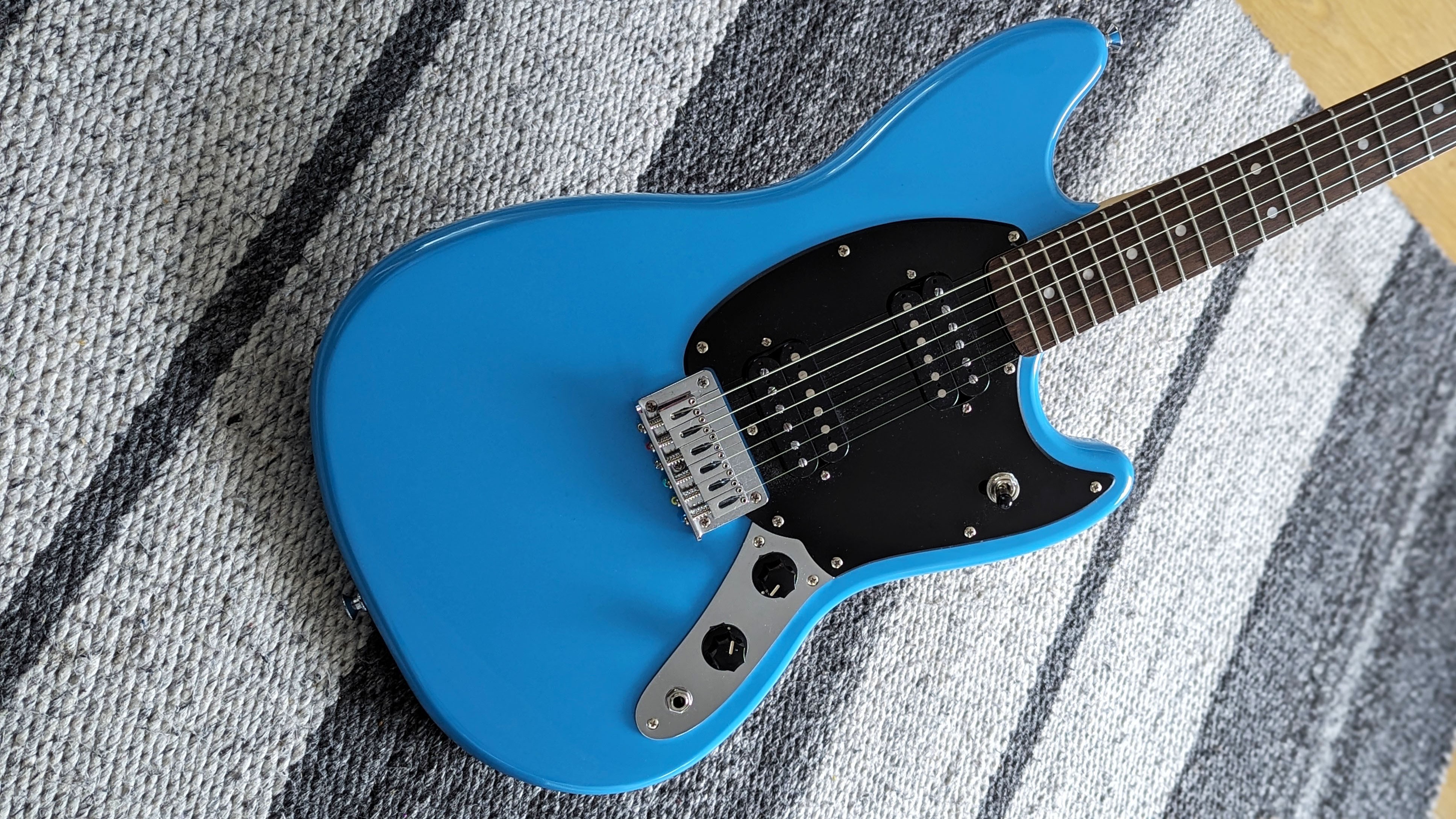
By Fender standards, the Mustang body is slight already and it usually makes for a lighter weight compared to Teles, Strats, Jags and Jazzmasters. That proves true here with 6.7lbs overall on my digital scales. I think this is another asset when it comes to making the guitar feel welcoming for any player, with a thin body depth measurement reading of 36mm with my calipers helping to bring this Mustang physically closer to the player and really enhancing the experience, making the lack of belly cut less of a loss. Indeed, this is actually thinner than my Player series Mustang that measures 39mm deep.
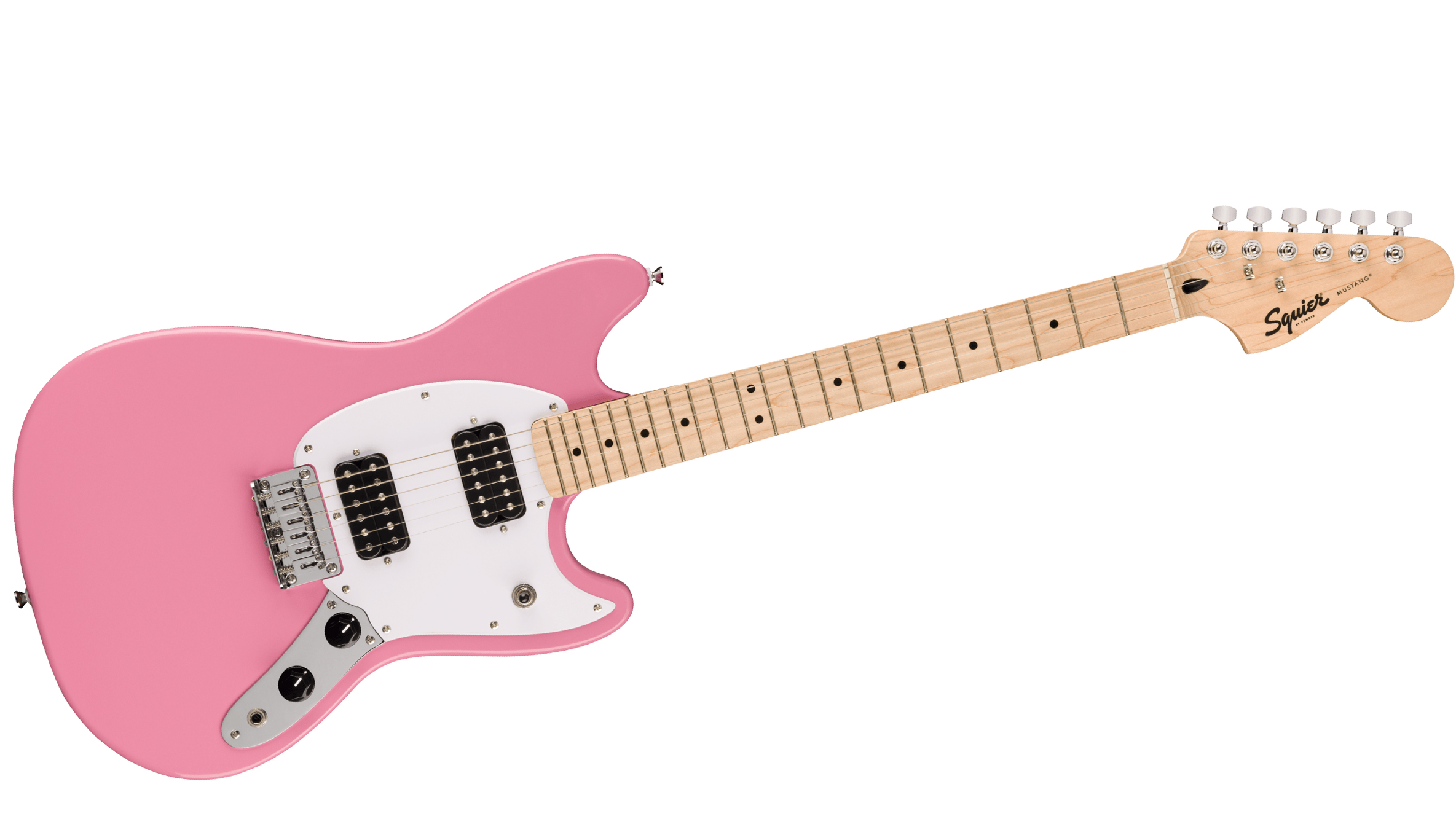
There are two Mustang options in the Sonic Series line and the other has single-coil pickups. The finish options for that configuration are 2-Color Sunburst, Torino Red and a Fender site exclusive Lime Green and in an ideal world, we'd have those finish options as well as the blue and pink for this humbucker model.
Personally, I'd love to see Squier offer HS models that offer a best-of-both-worlds sound potential for budding players with a humbucker in the bridge and a single-coil in the neck position – the Fender Player series Duo-Sonic is a rare example of this. But as that's not a possibility for the foreseeable future, I'd say that if you're into anything on the rockier side – pop punk, classic rock, heavy rock and metal – this HH model is the one to go for.

I'm actually surprised just how good both pickups sound for cleans
It'll cover those players better than the single-coil pickup Sonic Mustang for thicker-sounding power chords and palm-muting, and the humbuckers here don't disappoint for cleaner tones either.
Testing with a Fender Deluxe Reverb and my pedalboard leans towards more high-frequency cut, but bringing back the UAFX Lion '68 Super Lead amp emulator pedal I recently reviewed proves useful to get a wider perspective on things for Marshall Plexi tones.
They're a nicely balanced set of medium output 'buckers, with the bridge offering a little Fendery cut and some bright and lively definition under higher gain levels, but the neck gets quite mushy with chords in the same territory. Not a surprising issue, and it holds up well otherwise with some of the bolt-on construction snap helping to give it more definition than the dark-sounding neck humbuckers that can frequent this end of the price spectrum. I'm actually surprised just how good both pickups sound for cleans – a really strong blend of chime and thickness that could persuade single-coil players, and a middle position that delivers jangly goodness.
It's also worth noting the volume pot here isn't up to cleaning up your gain levels so there's definitely scope for an upgrade there later. That kind of tone shaping tends to come later for a player, and upgrading parts as you go along is always a good option with such a solid platform. And I think this guitar is worth that investment.
Squier Sonic Mustang HH review: Verdict
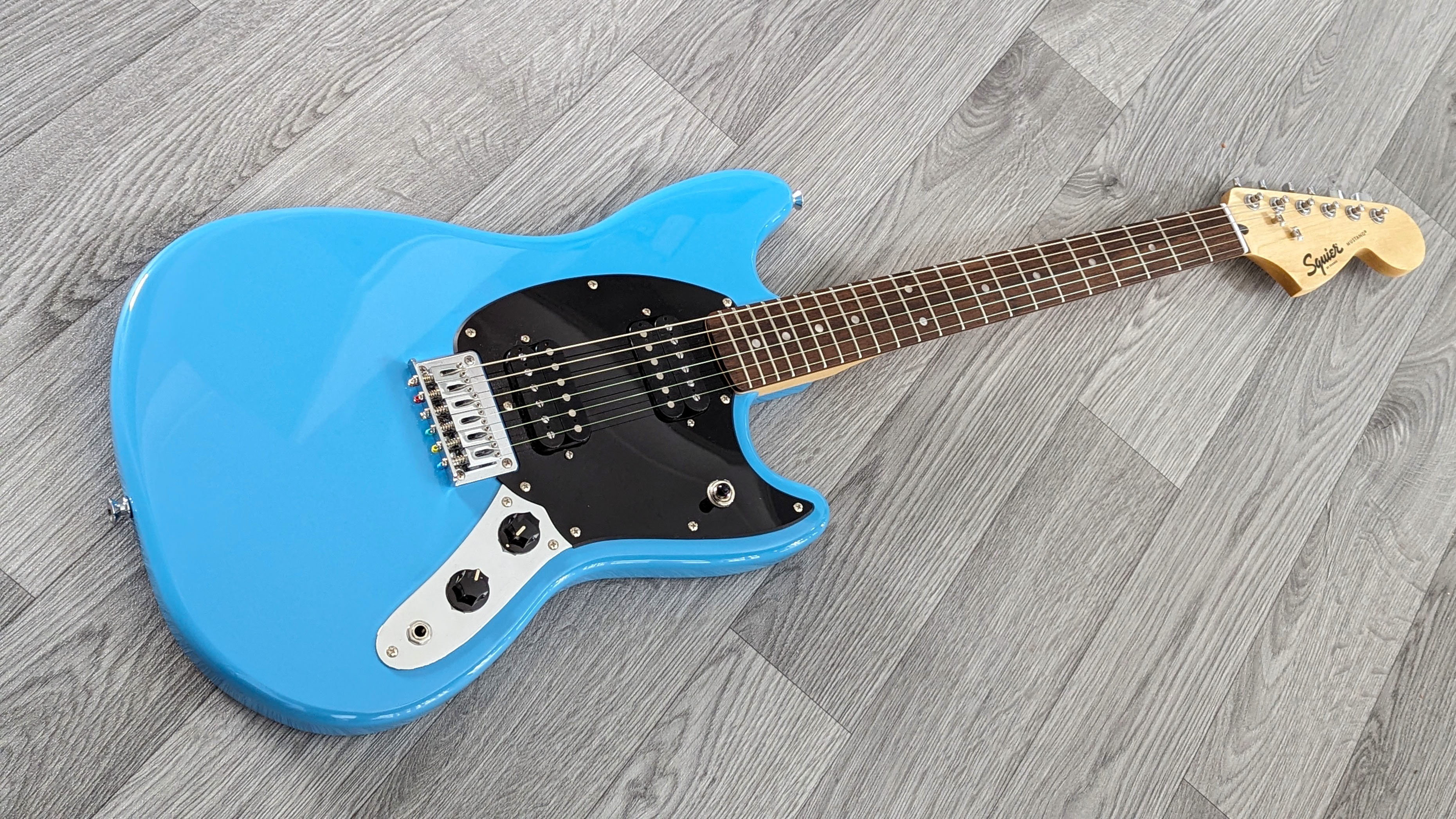
It's fun to play and this guitar could really help a newcomer build crucial confidence on the instrument faster
What's really clear for me after spending time with the Squier Sonic Mustang HH is just how much easier it all feels than a lot of other electric guitars I've played; the neck and scale length just encourage expression and finger stretches. It's fun to play and this guitar could really help a newcomer build crucial confidence on the instrument faster. This Mustang could well be the best beginner option in the Sonic series for that reason (random fact: it's also the only Sonic model in the current line-up with 22 frets).
Reassuringly, our test guitar stays in tune well too and I really focussed on pushing that side of things in the changeable room temperatures of a UK winter, plus plenty of bends! I'm really impressed, but also a little bitter that I didn't have this guitar when I was starting out. Today, it's a reminder of why the Mustang is my favourite Fender guitar, and this model is a benchmark for a beginner's electric guitar. If either of my children decide to learn I know which one I'll be buying them!
MusicRadar verdict: An excellent value electric guitar that offers a really positive playing experience for developing guitarists – and especially younger ones. The Mustang shape, versatile pickups and a very comfortable neck help to make this one of the best guitars for beginners available.
Squier Sonic Mustang HH review: Specifications
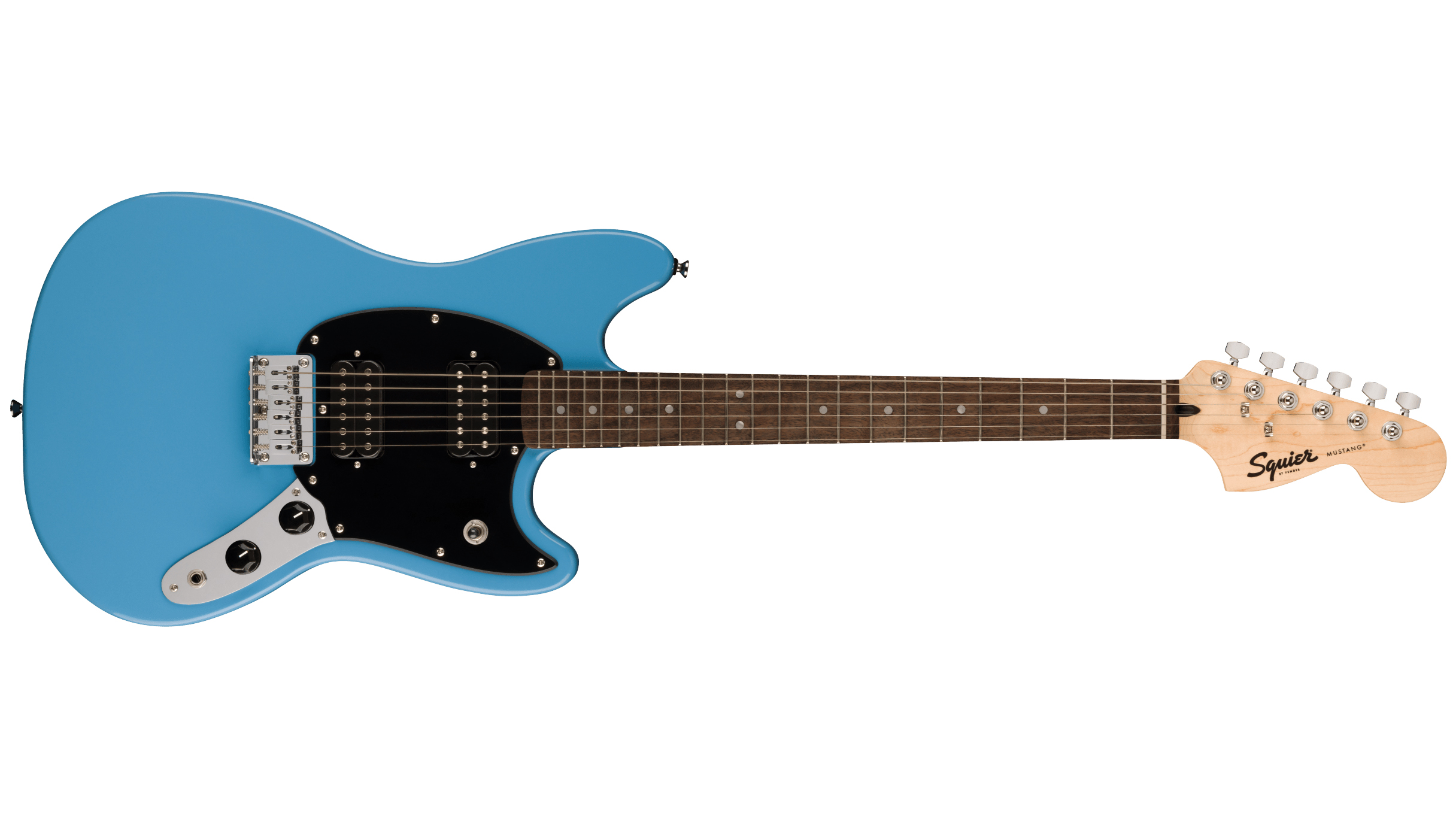
- ORIGIN: China
- TYPE: Six-string solid-body hardtail electric guitar
- BODY: Poplar
- NECK: Maple, C-shape, satin urethane
- FINGERBOARD: Indian Laurel, 9.5-inch radius
- FRETS: 22, Narrow Tall
- NUT: Synthetic bone, 42mm/1.65" width
- SCALE LENGTH: 24" (648mm)
- PICKUPS: 2 x Squier ceramic humbuckers
- CONTROLS: Master volume, master tone
- HARDWARE: Chrome 6-saddle (block saddles) hardtail bridge, sealed gear tuners,
- TEST GUITARS WEIGHT: 6.7lbs / 3.03kg
- CASE: No
- FINISH OPTIONS: California Blue (as reviewed), Flash Pink with maple fingerboard, Special Run model in Sonic Blue with maple fingerboard available to preorder at Andertons and Thomann, Fender site-exclusive Black / maple fingerboard at Fender.com
- CONTACT: Fender.com
Squier Sonic Mustang HH review: Hands-on demos
Fender
Dominic DeLaney
Cream City Music

Rob is the Reviews Editor for GuitarWorld.com and MusicRadar guitars, so spends most of his waking hours (and beyond) thinking about and trying the latest gear while making sure our reviews team is giving you thorough and honest tests of it. He's worked for guitar mags and sites as a writer and editor for nearly 20 years but still winces at the thought of restringing anything with a Floyd Rose.
